List_of_World_Heritage_Sites_in_Spain
The United Nations Educational, Scientific and Cultural Organization (UNESCO) World Heritage Sites are places of importance to cultural or natural heritage as described in the UNESCO World Heritage Convention, established in 1972.[1] Cultural heritage consists of monuments (such as architectural works, monumental sculptures, or inscriptions), groups of buildings, and sites (including archaeological sites). Natural features (consisting of physical and biological formations), geological and physiographical formations (including habitats of threatened species of animals and plants), and natural sites which are important from the point of view of science, conservation or natural beauty, are defined as natural heritage.[2] Spain ratified the convention on May 4, 1982, making its historical sites eligible for inclusion on the list.[3]
Sites in Spain were first inscribed on the list at the 8th Session of the World Heritage Committee, held in Buenos Aires, Argentina in 1984. At that session, five sites were added: the Cathedral of Our Lady of the Assumption, Córdoba; The Alhambra and the Generalife, Granada; Burgos Cathedral; Monastery and Site of the Escorial, Madrid; and Park Güell, Palau Güell and Casa Milà, in Barcelona.[4] Five sites were added in 1985, and another four in 1986. Apart from 1984, 1985, and 1986 (Spain's first three years as a member), 2000 saw the most new sites inscribed, with five that year. As of 2021[update], Spain has 49 total sites inscribed on the list, the same number as France, which is the fourth largest number of sites per country, only behind Italy (58), China (56), and Germany (51).[5] Of these 49 sites, 43 are cultural, 4 are natural, and 2 are mixed (meeting both cultural and natural criteria), as determined by the organization's selection criteria.[3]
Three sites are located in the Balearic Islands and four are in the Canary Islands. Four sites are transnational. The Pirineos – Monte Perdido World Heritage Site is shared with France, while the Prehistoric Rock-Art Sites in the Côa Valley and Siega Verde site is shared with Portugal. Almadén is inscribed alongside Idrija in Slovenia. The Ancient and Primeval Beech Forests of the Carpathians and Other Regions of Europe are shared with 17 other European countries.[3]
Additionally, Spain has established an agreement with UNESCO known as the Spanish Funds-in-Trust. The agreement was signed on April 18, 2002, between Francisco Villar, Spanish Ambassador and Permanent Delegate to UNESCO, and the Director-General of UNESCO, Kōichirō Matsuura. The fund provides €600,000 annually to a chosen program. Programs include helping other member states, particularly in Latin America, with projects such as nominations processes and assessing tentative sites.[6] Spain served as the chair of the World Heritage Committee in 2008 and 2009, and in 2009 hosted the 33rd Session of the Committee in Seville, Andalusia.[6]
UNESCO lists sites under ten criteria; each entry must meet at least one of the criteria. Criteria i through vi are cultural, and vii through x are natural.[7]
| Name | Image | Location | Community | UNESCO data | Period | Description |
|---|---|---|---|---|---|---|
| Cave of Altamira and Paleolithic Cave Art of Northern Spain | 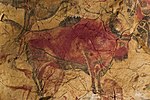 |
Santillana del Mar | Cantabria, Asturias, Basque Country | 310; 1985, 2008 (extended); i, iii | Upper Paleolithic | The Cave of Altamira contains examples of cave painting from the Upper Paleolithic period, ranging from 35,000 to 11,000 BC. The original listing contained seventeen decorated caves. The caves are well-preserved because of their deep isolation from the external climate.[8] |
| Old Town of Segovia and its Aqueduct |  |
Segovia | Castile and León | 311; 1985; i, iii, iv | 1st to 16th centuries | The Roman aqueduct was constructed in the 1st century, the medieval Alcázar palace in the 11th century, and the cathedral in the 16th.[9] |
| Monuments of Oviedo and the Kingdom of the Asturias | 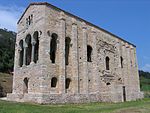 |
Oviedo | Asturias | 312; 1985, 1998 (extended); i, ii, iv | 9th century | The Kingdom of Asturias remained the only Christian region of Spain in the 9th century. It developed its own style of Pre-Romanesque art and architecture that is displayed in various churches and other monuments. The original entry titled "Churches of the Kingdom of the Asturias" and was extended to include other monuments such as La Foncalada.[10] |
| Historic Centre of Córdoba |  |
Córdoba | Andalusia | 313; 1984, 1994 (extended); i, ii, iii, iv | 7th to 13th centuries | The original listing was the Great Mosque of Córdoba, a 7th-century Catholic Church converted to a mosque in the 8th century; restored to a Roman Catholic cathedral in the 13th century by Ferdinand III. During the high period of the Moorish rule of the region, Córdoba had over 300 mosques and architecture that compared to that of Constantinople, Damascus, and Baghdad.[11] |
| Alhambra, Generalife and Albayzín |  |
Granada | Andalusia | 314; 1984, 1994 (extended); i, iii, iv | 14th century | The three sites are remnants of the Moorish influence in southern Spain. The fortress Alhambra and the palace Generalife were built by the rulers of the Emirate of Granada. The Albayzín district contains examples of the Moorish vernacular architecture and was added to the listing in 1994.[12] |
| Burgos Cathedral |  |
Burgos | Castile and León | 316; 1984; ii, iv, vi | 13th to 16th centuries | The Gothic-style cathedral was constructed between the 13th and 16th centuries. It is the burial place of Spanish national hero, El Cid.[13] |
| Monastery and Site of the Escorial |  |
San Lorenzo de El Escorial | Madrid | 318; 1984; i, ii, vi | 16th century | El Escorial is one of several Spanish royal sites due to its history as a residence of the royal family. The palace was designed by King Philip II and architect Juan Bautista de Toledo to serve as a monument to Spain's central role in the Christian world.[14] |
| Works of Antoni Gaudí | 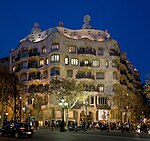 |
Barcelona | Catalonia | 320; 1984, 2005 (extended); i, ii, iv | 19th and 20th centuries | The architecture of Antoni Gaudí is part of the Modernist style, but his designs are described as highly unique. The original listing featured Park Güell, Palau Güell, and Casa Milà; the 2005 extension added Casa Vicens, the crypt and nativity façade of Sagrada Família, Casa Batlló, and the crypt at Colònia Güell.[15] |
| Santiago de Compostela (Old Town) | 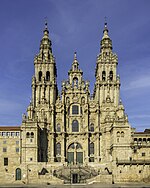 |
Santiago de Compostela | Galicia | 347; 1985; i, ii, vi | 10th and 11th centuries | The Cathedral of Santiago de Compostela is the reputed burial-place of the apostle James, and is the terminus of the Way of St. James, a pilgrimage across northern Spain. The town was destroyed by Muslims in the 10th century and rebuilt during the following century.[16] |
| Old Town of Ávila with its Extra-Muros Churches |  |
Ávila | Castile and León | 348; 1985, 2007 (modified); iii, iv | 11th century | The defensive wall surrounding the original town was constructed in the 11th century. It features 82 semicircular towers and 9 gates, and is one of the most complete examples of town walls in Spain.[17] |
| Mudéjar Architecture of Aragon |  |
Provinces of Teruel and Zaragoza | Aragon | 378; 1986, 2001 (extended); iv | 12th to 17th centuries | The original listing contained four churches in Teruel in the Mudéjar style, a blending of traditional Islamic and contemporary European styles. In 2001, the listing was expanded to include an additional six monuments.[18] |
| Historic City of Toledo |  |
Toledo | Castile-La Mancha | 379; 1986; i, ii, iii, iv | 8th to 16th centuries | Toledo was founded by the Romans, served as the capital of the Visigothic Kingdom, was important in Muslim Spain and during the Reconquista, and briefly served as the capital of Spain. The city combines Christian, Muslim, and Jewish influences.[19] |
| Garajonay National Park |  |
La Gomera | Canary Islands | 380; 1986; vii, ix | N/A | The park is 70% covered by laurisilva or laurel forest, vegetation from the Paleogene period that disappeared from mainland Europe due to climate change, but had covered much of the southern continent.[20] |
| Old City of Salamanca |  |
Salamanca | Castile and León | 381; 1988; i, ii, iv | 13th to 16th centuries | Salamanca is important as a university city, as the University of Salamanca, founded in 1218, is the oldest in Spain and among the oldest in Europe. The city was first conquered by the Carthaginians in the 3rd century, and later ruled by the Romans and Moors. The city centre represents Romanesque, Gothic, Moorish, Renaissance, and Baroque architecture.[21][22] |
| Cathedral, Alcázar and Archivo de Indias in Seville |  |
Seville | Andalusia | 383; 1987; i, ii, iii, iv | 13th to 16th centuries | The Alcázar was built during the Almohad dynasty that ruled southern Spain until the Reconquista. The cathedral dates to the 15th century and holds the tombs of Ferdinand III and Christopher Columbus. The Archivo (Archive) houses documents relating to the colonization of the Americas.[23] |
| Old Town of Cáceres |  |
Cáceres | Extremadura | 384; 1986; iii, iv | 3rd to 15th centuries | The old town combines Roman, Islamic, Northern Gothic, and Italian Renaissance architectural influences, including more than 30 Islamic towers.[24][25] |
| Ibiza, Biodiversity and Culture |  |
Ibiza | Balearic Islands | 417; 1999; ii, iii, iv, ix, x | N/A | The coast of Ibiza is home to posidonia oceanica, a seagrass only found in the Mediterranean that supports a diverse coastal and marine ecosystem. The island also contains numerous Phoenician ruins, and the fortified and walled older portions of the city date to the 16th century.[26] |
| Poblet Monastery |  |
Vimbodí | Catalonia | 518; 1991; i, iv | 12th and 13th centuries | The monastery was founded by the Cistercians in 1151 and is one of the largest in Spain. It a burial site and is associated with the Crown of Aragon.[27][28] |
| Renaissance Monumental Ensembles of Úbeda and Baeza |  |
Province of Jaén | Andalusia | 522; 2003; ii, iv | 16th century | Renovations of the two towns in the 16th century were done under the emerging Renaissance style and are among the first examples of the style in Spain.[29] |
| Archaeological Ensemble of Mérida |  |
Mérida | Extremadura | 664; 1993; iii, iv | 1st to 5th centuries | Mérida was founded in 25 BC by the Romans as Emerita Augusta and was the capital of the Lusitania province. Remains from the Roman era include a bridge, aqueduct, amphitheatre, theatre, circus, and forum.[30] |
| Royal Monastery of Santa María de Guadalupe |  |
Guadalupe | Extremadura | 665; 1993; iv, vi | 13th to 16th centuries | The monastery is home of Our Lady of Guadalupe, a shrine to Mary found in the 13th century after being buried from Muslim invaders in 714. The Virgin of Guadalupe and the monastery served as important symbols during the Reconquista, culminating in 1492, the same year as Columbus' discovery of America. The Guadalupe Virgin became an important symbol during the evangelization of America.[31][32] |
| Routes of Santiago de Compostela: Camino Francés and Routes of Northern Spain |  |
— | Aragon, Castile and León, Galicia, Navarre, and La Rioja | 669; 1993; ii, iv, vi | N/A | The Route, or the Way of St. James, Commonly known as Camino de Santiago, is a pilgrimage from the French-Spanish border to the Cathedral of Santiago de Compostela, where the apostle James is believed to be buried.[33] |
| Doñana National Park |  |
Provinces of Huelva and Seville | Andalusia | 685; 1994, 2005 (extended); vii, ix, x | N/A | The park consists of the delta region where the Guadalquivir River reaches the Atlantic Ocean. It is home to a diverse variety of biotopes, such as lagoons, marshlands, dunes, and maquis. The park is one of the largest heronries in the Mediterranean region and holds more than 500,000 water fowl during the winter period.[34] |
| Pirineos – Monte Perdido* |  |
Province of Huesca | Aragon (shared with France) | 773; 1997, 1999 (extended); iii, iv, v, vii, viii | N/A | The site contains the Pyrenees mountain chain along the French-Spanish border. The Spanish portion contains two of the largest canyons in Europe, while the French side contains three large cirque walls.[35] |
| Historic Walled Town of Cuenca |  |
Cuenca | Castile-La Mancha | 781; 1996; ii, v | 12th to 18th centuries | The Moors built the fortified city in the early 8th century, and it was captured by the Christians in the 12th century. The cathedral is the first Gothic example in Spain. The town is also famous for its casas colgadas, houses that hang over the edge of a cliff.[36][37] |
| La Lonja de la Seda de Valencia | 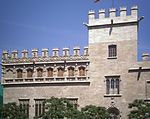 |
Valencia | Valencian Community | 782; 1996; i, iv | 15th and 16th centuries | La Lonja (or Llotja in Valencian language) de la Seda means Silk Exchange in English, and the group of Gothic buildings demonstrate the wealth of Valencia as an important Mediterranean and European mercantile city in the period.[38][39] |
| Las Médulas | 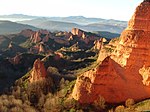 |
Ponferrada | Castile and León | 803; 1997; i, ii, iii, iv | 1st to 3rd centuries | The Romans established a gold mine and worked the site for two centuries. They used an early form of hydraulic mining and cut aqueducts in the rock cliffs to provide water for the operations. The Romans left in the early 3rd century, leaving sheer cliff faces and mining infrastructure that is intact today.[40][41] |
| Palau de la Música Catalana and Hospital de Sant Pau, Barcelona |  |
Barcelona | Catalonia | 804; 1997; i, ii, iv | 20th century | Both buildings were constructed in the early 20th century and designed by Lluís Domènech i Montaner in the modernist Art Nouveau movement that was very popular in Barcelona in that period. The two buildings are Montaner's most famous works.[42] |
| San Millán Yuso and Suso Monasteries |  |
San Millán de la Cogolla | La Rioja | 805; 1997; ii, iv, vi | 6th to 16th centuries | The original Suso monastery was founded in the mid-6th century, and is the location where the Glosas Emilianenses were written. The codixes are considered the first written examples of the Spanish and Basque languages, and the monastery is considered the birthplace of written and spoken Spanish. The newer Yuso monastery was built in the 16th century.[43] |
| Prehistoric Rock-Art Sites in the Côa Valley and Siega Verde* |  |
— | Castile and León (shared with Portugal) | 866; 1998, 2010 (extended); i, iii | Paleolithic | The original 1998 listing contained examples of Upper Paleolithic rock art in the Côa Valley of Portugal. In 2010 it was extended to include 645 engravings in the archaeological zone of Siega Verde in Spain. The two sites represent the most well-preserved collection of open-air Paleolithic art in the Iberian peninsula.[44] |
| Rock Art of the Mediterranean Basin on the Iberian Peninsula | 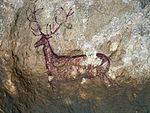 |
— | Andalusia, Aragon, Castile-La Mancha, Catalonia, Murcia, and Valencia | 874; 1998; iii | Prehistoric | The site includes over 750 examples of rock art from the late prehistoric period, which feature images ranging from geometric shapes to scenes of men hunting animals.[45][46] |
| Archaeological Ensemble of Tárraco |  |
Tarragona | Catalonia | 875; 2000; ii, iii | 1st to 4th centuries | The prominent Roman city of Tárraco at the site of modern-day Tarragona served as the capital of the provinces of Hispania Citerior and later Hispania Tarraconensis. The amphitheatre was constructed in the 2nd century. Most remains are only fragments or preserved under more modern buildings.[47][48] |
| University and Historic Precinct of Alcalá de Henares |  |
Alcalá de Henares | Madrid | 876; 1998; ii, iv, vi | 16th century | Cardinal Cisneros founded the University of Alcalá in 1499 and is the first example of the planned university city, serving as a model to other European universities and Spanish missionaries in America. The city is the birthplace of Miguel de Cervantes, known for his contributions to the Spanish language and Western literature.[49][50] |
| San Cristóbal de La Laguna | 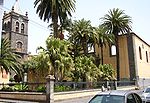 |
San Cristóbal de La Laguna | Canary Islands | 929; 1999; ii, iv | 16th to 18th centuries | The city has an original and unplanned Upper Town, and "city-territory" Lower Town. It was Spain's first non-fortified colonial town and served as a model for development in America. Many religious-function buildings and other public and private buildings date to the 16th century.[51][52] |
| Palmeral of Elche |  |
Elche | Valencian Community | 930; 2000; ii, v | N/A | The grove of date palm trees was formally laid out with irrigation systems under the Moors in the 10th century. The palmeral is a rare example of Arab agricultural practices in Europe.[53] |
| Roman Walls of Lugo |  |
Lugo | Galicia | 987; 2000; iv | 3rd century | The walls built to protect the Roman town of Lucus in the 3rd century remain entirely intact and are the best remaining example in Western Europe.[54] |
| Catalan Romanesque Churches of the Vall de Boí |  |
Vall de Boí | Catalonia | 988; 2000; ii, iv | 11th to 14th centuries | The small valley at the edge of the Pyrenees contains churches in Romanesque style decorated with Romanesque murals, statues, and altars. The churches are unique for their tall, square bell towers.[55][56] |
| Archaeological Site of Atapuerca |  |
Atapuerca | Castile and León | 989; 2000; iii, v | Prehistoric | The caves in the Atapuerca Mountains contain fossil remains of the earliest human beings discovered in Europe dating from nearly one million years ago. The Sima de los Huesos or "Pit of Bones" contains the world's largest collection of hominid fossils.[57][58] |
| Aranjuez Cultural Landscape |  |
Aranjuez | Madrid | 1044; 2001; ii, iv | 15th to 19th centuries | The landscape around the Royal Palace of Aranjuez was developed by the Spanish royal family over a course of three centuries and contains innovative horticultural and design ideas. The area was the exclusive property of the royal family until the 19th century when the modern civilian city developed.[59][60] |
| Vizcaya Bridge |  |
Portugalete | Basque Country | 1217; 2006; i, ii | 19th century | The bridge was designed by Alberto Palacio to cross the Nervion without disrupting maritime traffic to the Port of Bilbao. It was built in 1893 and is the world's first transporter bridge.[61][62] |
| Teide National Park | 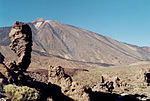 |
Tenerife | Canary Islands | 1258; 2007; vii, viii | N/A | The park contains Mount Teide, a volcano and the highest elevation in Spain.[63] |
| Tower of Hercules | 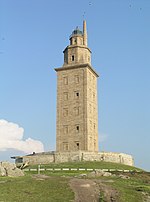 |
A Coruña | Galicia | 1312; 2009; iii | 1st century | The Romans built this 55 metres (180 ft) lighthouse on a 57 metres (187 ft) rock to mark the entrance to the A Coruña harbor. It is the only fully preserved and functioning Roman lighthouse.[64] |
| Cultural Landscape of the Serra de Tramuntana |  |
Majorca | Balearic Islands | 1371; 2011; ii, iv, v | N/A | The cultural landscape of Serra de Tramuntana on the north western coast of Majorca has been transformed by a millennia of agriculture involving water management devices such as agricultural terraces, interconnected water works -including water mills - and dry stone constructions and farms. This landscape revolves around farming units of feudal origins.[65] |
| Heritage of Mercury. Almadén and Idrija* |  |
Almadén | Castile-La Mancha (shared with Slovenia) | 1313; 2012; ii, iv | 16 and 17th century | Almaden is an ancient (from Roman times to present day) mercury mining town with buildings relating to its mining history, including Retamar Castle, religious buildings, mining university and traditional dwellings.[66] |
| Antequera Dolmens Site | 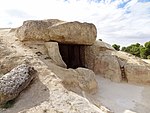 |
Antequera | Andalusia | 1501; 2016; i, iii, iv | Neolithic and Chalcolithic | Located at the heart of Andalusia in southern Spain, the site comprises three megalithic monuments: the Menga and Viera dolmens and the Tholos of El Romeral, and two natural monuments: La Peña de los Enamorados and El Torcal mountainous formations, which are landmarks within the property. Built during the Neolithic and Bronze Age out of large stone blocks, these monuments form chambers with lintelled roofs or false cupolas. These three tombs, buried beneath their original earth tumuli, are one of the most remarkable architectural works of European prehistory and one of the most important examples of European Megalithism.[67] |
| Ancient and Primeval Beech Forests of the Carpathians and Other Regions of Europe* |  |
Castile and León, Navarre, Castile-La Mancha, and Community of Madrid (shared with 11 other countries in Europe) | 1133; 2017; ix | N/A | Primeval Beech Forests of the Carpathians are used to study the spread of the beech tree (Fagus sylvatica) in the Northern Hemisphere across a variety of environments and the environment in the forest. The addition of the Ancient Beech Forests of Germany in 2011 included five forests totaling 4,391 hectares (10,850 acres) that are added to the 29,278 hectares (72,350 acres) of Slovakian and Ukrainian beech forests inscribed on the World Heritage List in 2007. The site was further expanded in 2017 to include forests in 9 additional European countries.[68] | |
| Caliphate City of Medina Azahara |  |
Córdoba | Andalusia | 1560; 2018; iii, iv | N/A | The Caliphate city of Medina Azahara is an archaeological site of a city built in the mid-10th century CE by the Umayyad dynasty as the seat of the Caliphate of Cordoba. After prospering for several years, it was laid to waste during the civil war that put an end to the Caliphate in 1009–10.[69] |
| Risco Caído and the sacred mountains of Gran Canaria Cultural Landscape |  |
Gran Canaria island | Canary Islands | 1578; 2019
iii, v |
[70] | |
| Paseo del Prado and Buen Retiro, a landscape of Arts and Sciences |  |
Madrid | Madrid | 1500; 2020
ii, iv, vi |
[71] | |
| Prehistoric Sites of Talayotic Menorca |  |
Menorca island | Balearic Islands | 1528; 2023
iii, iv |
Iron Age | [72] |
Sites by autonomous community
Exclusive sites refer to sites locating in a single community. Shared sites refer to sites with entries in multiple communities, including Pirineos – Monte Perdido, which Aragon shares with France, Prehistoric Rock-Art Sites in the Côa Valley and Siega Verde, which Castile and León shares with Portugal and Ancient and Primeval Beech Forests which Navarre, Castile and León, Community of Madrid and Castile-La Mancha shares with other countries of Europe.
| Community | Exclusive sites | Shared sites | Total |
|---|---|---|---|
| Castile and León | 6 | 3 | 9 |
| Andalusia | 7 | 1 | 8 |
| Catalonia | 5 | 1 | 6 |
| Castile-La Mancha | 2 | 3 | 5 |
| Madrid | 4 | 1 | 5 |
| Aragon | 1 | 3 | 4 |
| Canary Islands | 4 | — | 4 |
| Galicia | 3 | 1 | 4 |
| Asturias | 1 | 2 | 3 |
| Extremadura | 3 | — | 3 |
| Valencian Community | 2 | 1 | 3 |
| Balearic Islands | 3 | — | 3 |
| Basque Country | 1 | 1 | 2 |
| Cantabria | — | 2 | 2 |
| La Rioja | 1 | 1 | 2 |
| Navarre | — | 2 | 2 |
| Murcia | — | 1 | 1 |
In addition to sites inscribed on the World Heritage List, member states can maintain a list of tentative sites that they may consider for nomination. Nominations for the World Heritage List are only accepted if the site was previously listed on the tentative list.[73] As of 2016, Spain recorded 32 sites on its tentative list. At 2018, the sites, along with the year they were included on the tentative list are:[74][3]
- Romanesque Cultural Enclave in the North of Castile and León and the South of Cantabria (Palencia Province and Cantabria) (1998)
- Bulwarked Frontier Fortifications (Aragon, Castile and León, Catalonia, Extremadura and Navarre) (1998)
- The Silver Route (Castile and León and Extremadura) (1998)
- Mediterranean Wind Mills (Region of Murcia) (1998)
- Greek Archaeological ensemble in Empúries, l'Escala, Girona Province (2002)
- The Ribeira Sacra (Lugo and Ourense provinces) (1996)
- The Mediterranean Facet of the Pyrenees (Girona Province-France) (2004)
- Talayotic culture of Minorca (Minorca island) (2013) (admitted into the World Heritage List in 2023)
- Mesta Livestock trails (includes Cañadas Reales) (Castile and León) (2007)
- Roman Ways. Itineraries of the Roman Empire (Andalusia, Castile-La Mancha, Catalonia and Valencian Community) (shared with other countries) (2007)
- Ancares – Somiedo (Galicia, Castile and León and Asturias) (2007)
- Loarre Castle (Aragon) (2007)
- Ferrol of the Illustration Historical Heritage (Galicia) (2007)
- Mining Historical Heritage (2007)
- Plasencia - Monfragüe - Trujillo: Mediterranean Landscape (Extremadura) (2009)
- Jaén Cathedral (extension of the Renaissance Monumental Ensembles of Úbeda and Baeza) (2012)
- Salty Valley of Añana (Basque Country) (2012)
- La Rioja and Rioja Alavesa Vine and Wine Cultural Landscape (La Rioja and Basque Country) (2013)
- Priorat - Montsant - Siurana. Agricultural Landscape of the Mediterranean Mountain (Catalonia) (2014)
- Site of the Retiro and the Prado in Madrid (2015) (admitted into the World Heritage List in 2021)
- The Portal of the Ripoll Monastery (Catalonia) (2015)
- Hill of the Seu Vella of Lleida (2016)
- Monastery of Santa María de La Rábida and the Columbus Memorial Places in Huelva (2016)
- Church of San Salvador de Valdediós (Asturias) (2017)
- The Olive Grove Landscapes of Andalusia (2017)
- The Wine in Iberia (Region of Murcia, Andalusia and Valencian Community) (2018)
- Cíes Islands – Atlantic Islands of Galicia National Park (2018)
- The Hadrianic city of Italica (2019)
- Group of Mozarabic buildings on the Iberian Peninsula (2019)
- The Episcopal See of Egara and its pictorial decoration (5th-8th centuries) (2019)
- Les témoignages matériels de la construction de l’État des Pyrénées : la Co-principauté d’Andorre (Spain) (2021)
- Sigüenza and Atienza Sweet and Salty Landscape (2022)
- "The World Heritage Convention". UNESCO World Heritage Centre. Archived from the original on 27 August 2016. Retrieved 7 July 2019.
- "Convention Concerning the Protection of the World Cultural and Natural Heritage". UNESCO World Heritage Centre. Archived from the original on 1 February 2021. Retrieved 3 February 2021.
- "Spain – Properties inscribed on the World Heritage List". UNESCO. Retrieved September 17, 2010.
- "Report of the Rapporteur". UNESCO. November 2, 1984. Retrieved September 17, 2010.
- "UNESCO WHS list". UNESCO. Retrieved 6 December 2021.
- "Spanish Funds-in-Trust". UNESCO. Retrieved September 17, 2010.
- "UNESCO World Heritage Centre – The Criteria for Selection". UNESCO World Heritage Centre. Retrieved 17 August 2018.
- "Cave of Altamira and Paleolithic Cave Art of Northern Spain". UNESCO. Retrieved September 15, 2010.
- "Old Town Segovia and its Aqueduct". UNESCO. Retrieved September 15, 2010.
- "Monuments of Oviedo and the Kingdom of the Asturias". UNESCO. Retrieved September 15, 2010.
- "Historic Centre of Cordoba". UNESCO. Retrieved September 15, 2010.
- "Alhambra, Generalife, and Albayzin". UNESCO. Retrieved September 15, 2010.
- "Burgos Cathedral". UNESCO. Retrieved September 15, 2010.
- "Monastery and Site of the Escorial". UNESCO. Retrieved September 15, 2010.
- "Works of Antoni Gaudi". UNESCO. Retrieved September 15, 2010.
- "Santiago de Compostela (Old Town)". UNESCO. Retrieved September 15, 2010.
- "Old Town of Avila with its Extra-Muros Churches". UNESCO. Retrieved September 15, 2010.
- "Mudejar Architecture of Aragaon". UNESCO. Retrieved September 15, 2010.
- "Historic City of Toledo". UNESCO. September 15, 2010.
- "Garajonay National Park". UNESCO. Retrieved September 15, 2010.
- "Old City of Salamanca". UNESCO. Retrieved September 15, 2010.
- "Importancia Historica" (in Spanish). Salamanca Patrimonio. Archived from the original on 2012-07-28. Retrieved September 15, 2010.
- "Cathedral, Alcazar, and Archivo de Indias in Sevilla". UNESCO. Retrieved September 15, 2010.
- "Old Town of Cáceres". UNESCO. Retrieved September 15, 2010.
- "Introducción" (in Spanish). Ayuntamiento de Cáceres. Archived from the original on September 29, 2010. Retrieved September 15, 2010.
- "Ibiza, Biodiversity and Culture". UNESCO. Retrieved September 17, 2010.
- "Poblet Monastery". UNESCO. Retrieved September 15, 2010.
- "World Heritage List, No. 518 Rev" (PDF). UNESCO. January 3, 1989. Retrieved September 15, 2010.
- "Renaissance Monumental Ensembles of Ubeda and Baeza". UNESCO. Retrieved September 15, 2010.
- "Archaeological Ensemble of Mérida". UNESCO. Retrieved September 16, 2010.
- "Royal Monastery of Santa María de Guadalupe". UNESCO. Retrieved September 16, 2010.
- "Guadalupe" (PDF). UNESCO. September 25, 1992. Retrieved September 16, 2010.
- "Route of Santiago de Compostela". UNESCO. Retrieved September 15, 2010.
- "Doñana National Park". UNESCO. Retrieved September 15, 2010.
- "Pyrenees – Mont Perdu". UNESCO. Retrieved September 15, 2010.
- "Historic Walled Town of Cuenca". UNESCO. Retrieved September 16, 2010.
- Cook, William (October 2, 2009). "A stroll through La Mancha". The Guardian. London. Archived from the original on October 13, 2014. Retrieved September 16, 2010.
- "La Lonja de la Seda de Valencia". UNESCO. Retrieved September 16, 2010.
- "La lonja de Valencia. Limpieza y conversación de fachadas" (in Spanish). Colegio Territorial de Arquitectos de Valencia. 2005. Archived from the original on July 29, 2012. Retrieved September 16, 2010.
- "Las Médulas". UNESCO. Retrieved September 16, 2010.
- "The archaeology of a mining landscape". Fundación Las Médulas. 2003. Archived from the original on August 23, 2010. Retrieved September 16, 2010.
- "Palau de la Música Catalana and Hospital de Sant Pau, Barcelona". UNESCO. Retrieved September 17, 2010.
- "San Millán Yuso and Suso Monasteries". UNESCO. Retrieved September 17, 2010.
- "Prehistoric Rock-Art Sites in the Côa Valley and Siega Verde". UNESCO. Retrieved September 17, 2010.
- "Rock Art of the Mediterranean Basin on the Iberian Peninsula". UNESCO. Retrieved September 15, 2010.
- "Arte Rupestre del Arco Mediterráneo Peninsular". Instituto de Turismo de España. Retrieved September 17, 2010.
- "Archaeological Ensemble of Tárraco". UNESCO. Retrieved September 17, 2010.
- "Patrimoni Històric" (in Catalan). Ajuntament de Tarragona. Archived from the original on September 30, 2010. Retrieved September 17, 2010.
- "University and Historic Precinct of Alcalá de Henares". UNESCO. Retrieved September 17, 2010.
- "Alcalá de Henares". Ciudades Patrimonio de la Humanidad de España. Archived from the original on September 1, 2010. Retrieved September 17, 2010.
- "San Cristóbal de La Laguna". UNESCO. Retrieved September 17, 2010.
- "Historia" (in Spanish). Ayuntamiento de La Laguna. Archived from the original on September 26, 2010. Retrieved September 17, 2010.
- "Palmeral of Elche". UNESCO. Retrieved September 17, 2010.
- "Roman Walls of Lugo". UNESCO. Retrieved September 17, 2010.
- "Catalan Romanesque Churches of the Vall de Boí". UNESCO. Retrieved September 17, 2010.
- "El conjunt romànic de la Vall de Boí" (in Catalan). Patronat de la Vall de Boí. Archived from the original on January 1, 2013. Retrieved September 17, 2010.
- "Archaeological Site of Atapuerca". UNESCO. Retrieved September 17, 2010.
- "Sima de los Huesos: The Pit of Bones". American Museum of National History. Archived from the original on November 23, 2010. Retrieved September 17, 2010.
- "Aranjuez Cultural Landscape". UNESCO. Retrieved September 17, 2010.
- "Aranjuez (Spain)" (PDF). UNESCO. June 30, 2000. Retrieved September 17, 2010.
- "Vizcaya Bridge". UNESCO. Retrieved September 17, 2010.
- "History of the Bridge". Puente Vizcaya World Heritage. Archived from the original on July 15, 2011. Retrieved September 17, 2010.
- "Teide National Park". UNESCO. Retrieved September 17, 2010.
- "Tower of Hercules". UNESCO. Retrieved September 15, 2010.
- "Cultural Landscape of the Serra de Tramuntana". UNESCO. Retrieved July 23, 2012.
- "Heritage of Mercury. Almadén and Idrija". UNESCO. Retrieved July 23, 2012.
- "Antequera Dolmens Site". UNESCO. Retrieved September 2, 2016.
 This article incorporates text from this source, which is in the public domain.
This article incorporates text from this source, which is in the public domain. - "Ancient and Primeval Beech Forests of the Carpathians and Other Regions of Europe". UNESCO. Retrieved 7 September 2017.
- "Risco Caido and the Sacred Mountains of Gran Canaria Cultural Landscape". UNESCO World Heritage Centre. Retrieved 2019-07-09.
- "Paseo del Prado and Buen Retiro, a landscape of Arts and Sciences". UNESCO World Heritage Centre. Retrieved 2021-07-25.
- "Prehistoric Sites of Talayotic Menorca". UNESCO World Heritage Centre. Retrieved 2023-09-18.
- "Tentative Lists". UNESCO. Retrieved July 23, 2012.
- "Tentative Lists, Spain". UNESCO. January 29, 2016. Retrieved January 25, 2017.